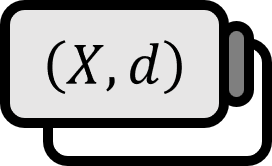Convergence of Cauchy Sequences in Metric Spaces
Definition
Let $\left\{ p_{n} \right\}$ be a sequence of points in a metric space $(X,d)$. If for every positive number $\varepsilon$, there exists a positive number $N$ such that
$$ n\ge N,\ m\ge N \implies d(p_{n},p_{m})<\varepsilon $$
is satisfied, then $\left\{ p_{n} \right\}$ is called a Cauchy sequence.
If every Cauchy sequence in a metric space $X$ converges to a point in $X$, then $X$ is called a complete space.
Explanation
From the following theorem, it can be seen that every compact metric space and Euclidean space is complete.
Theorem
(a) In a metric space, every converging sequence is a Cauchy sequence.
(b) Let $X$ be a compact metric space and $\left\{ p_{n} \right\}$ be a Cauchy sequence in $X$. Then, $\left\{ p_{n} \right\}$ converges to some $p\in X$.
(c) In $\mathbb{R}^{k}$, all Cauchy sequences converge.
(a) and (b) together imply ‘In a compact metric space, converging sequences and Cauchy sequences are equivalent.’
Proof
(a)
Let $p_{n} \to p$ and $\varepsilon >0$ be given. Then, there exists $N$ satisfying $\forall n \ge N,\ d(p,p_{n})<\varepsilon$. Therefore, the following is satisfied:
$$ d(p_{n},p_{m}) \le d(p_{n},p)+d(p,p_{m})<2\varepsilon,\quad \forall m,n\ge N $$
Therefore, by definition, $\left\{ p_{n} \right\}$ is a Cauchy sequence.
■
(b)
Let $\left\{ p_{n} \right\}$ be a Cauchy sequence in the compact metric space $X$. And let it be said for any natural number $N$:
$$ E_{N}=\left\{ p_{N},p_{N+1},p_{N+2},\cdots\right\} $$
Then, the following is satisfied:
Moreover, $\overline{E_{N}}$ is a closed subset of the compact space $X$, so $\overline{E_{N}}$ is compact. It is also evident that the following equation is satisfied:
$$ E_{N}\supset E_{N+1} \quad \text{and} \quad \overline{E_{N}}\supset \overline{E_{N+1}} $$
Therefore, from the above conditions, it can be seen that there exists a unique $p \in X$ satisfying $\forall N \in \mathbb{N},\ p \in \overline{E_{N}}$1. Now, let $\varepsilon >0$ be given. Then, by $\eqref{eq1}$,
$$ N \ge N_{0}\implies \mathrm{diam\ }\overline{E_{N}}< \varepsilon $$
a $N_{0}$ exists that satisfies the condition. But since $\mathrm{diam\ }\overline{E}=\mathrm{diam\ }E$ and $p \in \overline{E_{N}}$, for all $q \in E_{N}$, $d(p,q)<\varepsilon$ is satisfied. In other words, the following is implied:
$$ n \ge N_{0} \implies d(p_{n},p)< \varepsilon $$
This is the definition of $p_{n}\to p$, therefore $\lim \limits_{n\to\infty} p_{n}=p$
■
(c)
Let $\left\{ \mathbf{x}_{n} \right\}$ be a Cauchy sequence in $\mathbb{R}^{k}$. Assuming $E_{N}$ as the proof of (b), then
$$ \mathrm{diam\ } E_{N} <1 $$
let a $N$ be chosen that satisfies the condition. And
$$ r=\max \left\{ d(\mathbf{x}_{N},\mathbf{x}_{1}),\ d(\mathbf{x}_{N},\mathbf{x}_{2}),\ \cdots,\ d(\mathbf{x}_{N},\mathbf{x}_{N-1}),\ 1 \right\} $$
since $\forall m,n \in \mathbb{N},\ d(\mathbf{x}_{n},\mathbf{x}_{m}) <r$, $\left\{ \mathbf{x}_{n} \right\}$ is bounded. Therefore, $\overline{ \left\{ \mathbf{x}_{n} \right\}}$ is a closed and bounded subset of $\mathbb{R}^{k}$, hence compact. Therefore, $\left\{ \mathbf{x}_{n} \right\}$ is a Cauchy sequence in a compact space, and thus by (b), $\left\{ \mathbf{x}_{n} \right\}$ converges.
■
See theorem (b) ↩︎
